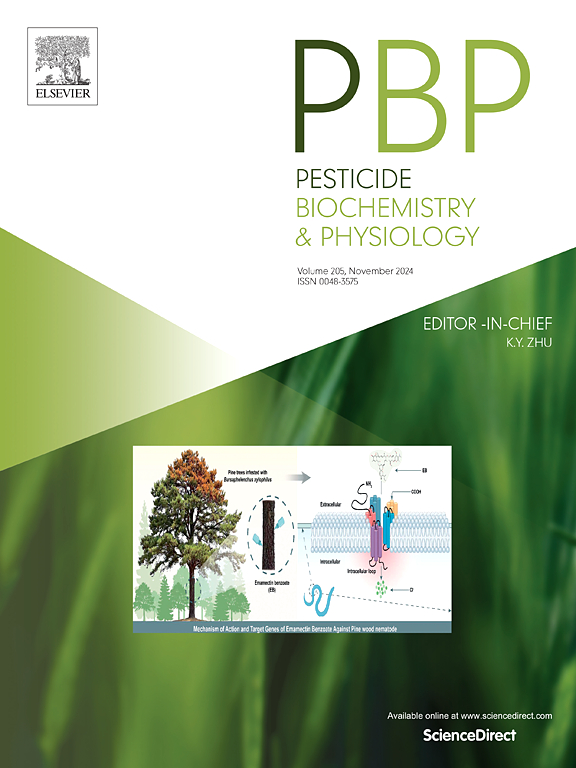Antifungal activity and potential inhibition mechanism of 4-(diethylamino)salicylaldehyde against Rhizoctonia solani
IF 4.2
1区 农林科学
Q2 BIOCHEMISTRY & MOLECULAR BIOLOGY
引用次数: 0
Abstract
Rhizoctonia solani is a significant soil-borne pathogenic fungus that poses a significant threat to the economically important agricultural crops. 4-(Diethylamino)salicylaldehyde (DSA) is a secondary metabolite produced by Streptomyces sp. KN37, which has antifungal activity, meanwhile its inhibitory mechanism is still unclear. In this study, we explored the antifungal efficacy of DSA and its potential mechanism of inhibiting R. solani. It was found that DSA exhibited significant antifungal activity against six tested plant pathogenic fungi, with R. solani being the most sensitive (EC50 = 26.904 μg/mL). Notably, DSA effectively reduced the mycelial mass and inhibited sclerotia germination, demonstrating a good control efficacy of cucumber damping-off disease. Morphological observation showed that DSA significantly disrupted the shape and ultrastructure of the mycelium. Transcriptomic and metabolomic analyses revealed that DSA impacted the integrity of the cell membrane, redox processes, and energy metabolism in R. solani. The results of fluorescence staining, relative conductivity, H2O2 content, and antioxidant enzyme activity showed that the accumulation of ROS in hypha cells after DSA treatment possibly resulted in damage to cell membrane integrity. Furthermore, the reduction in ATP content, along with decreased ATPase and citrate synthase activity, indicates that energy production may be inhibited. Molecular docking analysis further showed that DSA may competitively inhibit citrate synthase, thereby inhibiting cell energy production and ultimately inducing apoptosis. Our study provides new insights into the potential mechanism by which DSA inhibits the mycelial growth of R. solani.

4-(二乙胺)水杨醛对茄枯丝核菌的抑菌活性及潜在抑制机制
枯丝核菌是一种重要的土传致病菌,对重要的经济作物造成严重威胁。4-(二乙胺)水杨醛(DSA)是Streptomyces sp. KN37产生的次生代谢物,具有抗真菌活性,但其抑制机制尚不清楚。在本研究中,我们探讨了DSA的抗真菌作用及其抑制番茄枯萎病的可能机制。结果表明,DSA对6种植物病原真菌均有显著的抑菌活性,其中对茄枯病菌最敏感(EC50 = 26.904 μg/mL)。DSA能有效地减少菌丝体数量,抑制菌核萌发,显示出良好的黄瓜灭湿防治效果。形态学观察表明,DSA显著破坏了菌丝的形态和超微结构。转录组学和代谢组学分析表明,DSA影响了茄茄细胞膜的完整性、氧化还原过程和能量代谢。荧光染色、相对电导率、H2O2含量和抗氧化酶活性结果表明,DSA处理后菌丝细胞中ROS的积累可能导致细胞膜完整性受损。此外,ATP含量的降低以及ATP酶和柠檬酸合成酶活性的降低表明能量产生可能受到抑制。分子对接分析进一步表明,DSA可能竞争性地抑制柠檬酸合成酶,从而抑制细胞能量产生,最终诱导细胞凋亡。本研究为DSA抑制茄茄菌菌丝生长的潜在机制提供了新的见解。
本文章由计算机程序翻译,如有差异,请以英文原文为准。
求助全文
约1分钟内获得全文
求助全文
来源期刊
CiteScore
7.00
自引率
8.50%
发文量
238
审稿时长
4.2 months
期刊介绍:
Pesticide Biochemistry and Physiology publishes original scientific articles pertaining to the mode of action of plant protection agents such as insecticides, fungicides, herbicides, and similar compounds, including nonlethal pest control agents, biosynthesis of pheromones, hormones, and plant resistance agents. Manuscripts may include a biochemical, physiological, or molecular study for an understanding of comparative toxicology or selective toxicity of both target and nontarget organisms. Particular interest will be given to studies on the molecular biology of pest control, toxicology, and pesticide resistance.
Research Areas Emphasized Include the Biochemistry and Physiology of:
• Comparative toxicity
• Mode of action
• Pathophysiology
• Plant growth regulators
• Resistance
• Other effects of pesticides on both parasites and hosts.

 求助内容:
求助内容: 应助结果提醒方式:
应助结果提醒方式:


